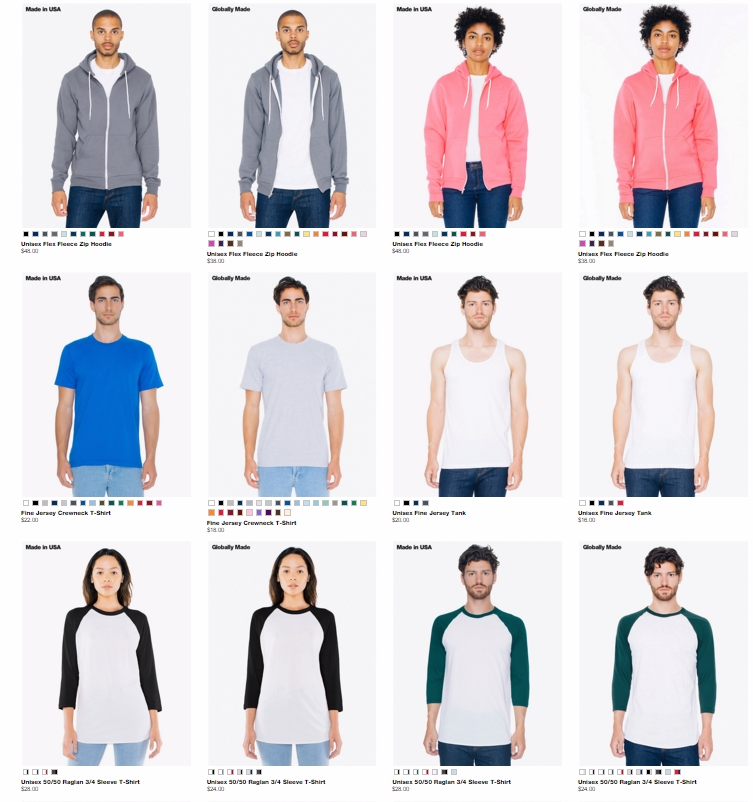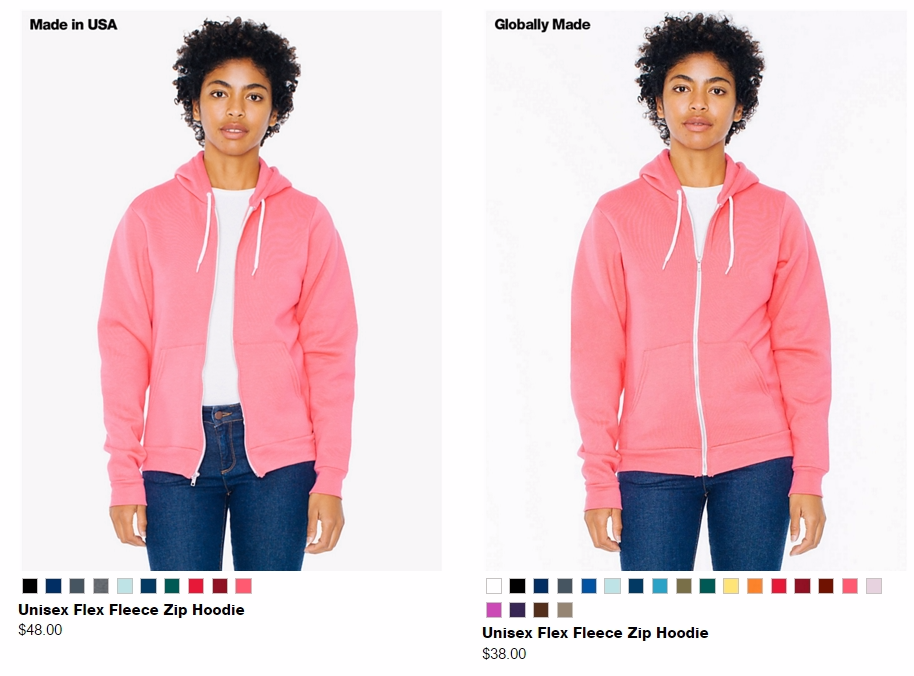
The relaunched brand is belittling its American-made roots.
American Apparel is back with new ownership — and apparently a whole new attitude.
Once known for making its entire line of tees, tanks, pants and hoodies in downtown Los Angeles, American Apparel is now owned by Canadian company Gildan Activewear and is calling itself a “globally sourced” brand. Although the new American Apparel is still selling the casual basics it’s always been known for, the retailer is now making most of its stuff abroad.
As GQ noted, it’s unclear where and how all that stuff is being manufactured, although American Apparel’s website claims it is “ethically made” and “sweatshop free.” There’s also a short video with a factory worker in Honduras named Heber who talks about his job and the opportunities it provides.
Now, none of this would be worth writing about had it not been for the company’s outrageous treatment of its Made in America roots.
American Apparel now has a Made in USA eight-piece “capsule collection.” It claims the collection is for customers who shop the brand because of its American-made merchandise. But unlike many retailers who market their capsule collections as special and coveted — think about Target’s regular capsules with top designers like Victoria Beckham and Jason Wu, for example — the retailer is pinning each American-made item right against its “globally produced” twin.
For example, take the “Unisex Flex Fleece Zip Hoodie.” The Made in USA option retails for $48 and is available in 10 colors; the “globally made” version sells for $38 and is available in 21 colors.

What an insult.
Let’s be clear from the start: We’re not criticizing people like Heber, who like anyone else deserves the chance to work at a good job that provides opportunity for his family. And if Gildan wants to make American Apparel merchandise abroad, fine — as American-made supporters we find it disappointing, but the company has the right to make its stuff where it wants to.
What we’re insulted by is how American Apparel’s new ownership is now going out of its way to disparage its American-made roots. Here’s GQ:
Gildan might still be calling the brand American Apparel, and leaning into the original AA’s history as a provocative, activism-driven brand, but it’s clear they think [the] whole made-in-America thing is beside the point. The USA-made capsule effectively functions as reverse marketing for the main, internationally-produced (sorry, "Globally Produced") line.
The new American Apparel is essentially ridiculing American apparel.
It’s important here to remember the early days of American Apparel. The brand launched in the late 1990s and opened its downtown L.A. factory in 2000, at a time when textile manufacturing was quickly moving overseas.
The company branded itself as a hip (and very sexy) alternative to much of the clothing being made abroad. But American Apparel also offered a way for consumers to become advocates via their wallet.
At the time, stories were beginning to emerge about how most of the globally made apparel sold in American stores was made in sweatshops, with workers — sometimes including children — forced to work long hours in terrible conditions. Meanwhile, American communities that once depended on apparel manufacturing were suffering.
For a time, American Apparel soared, selling $125 million worth of merchandise in 2007 alone.
The company began to run into trouble around 2010, but not because of its American-made model. Rather, the allegedly “salacious behavior” (to put it mildly) of founder and CEO Dov Charney put the entire company in hot water; Charney was eventually ousted by the board of directors in 2014.
By that time, it was too late. American Apparel filed for bankruptcy in 2015, and Gildan purchased the company’s intellectual property and some manufacturing equipment earlier this year. Gildan declined to buy American Apparel’s California production facilities or distribution center — as a result, 3,400 L.A.-area workers lost their jobs (along with the company’s retail workers, as Gildan also declined to assume leases on the chain’s 110 stores).
So, it was clear from the start that Gildan has no interest in maintaining American Apparel’s American-made legacy.
Again, while we’re disappointed by that, the company has the right to make its merchandise abroad (just as we have the right to buy our fashion-forward hoodies elsewhere).
It’s the dismissive way Gildan is positioning its American-made American apparel that has us irked.
Gildan should remember that many customers shopped American Apparel because they knew it was made in Los Angeles — not in a sweatshop overseas. Maybe they were concerned about child labor, or perhaps they wanted to support U.S. workers or the California economy.
In any case, those are legitimate, worthwhile reasons to shop Made in America.
Now Gildan is trying to have its cake and eat it, too — it wants to position itself as a brand with a conscience while also maligning the very thing that made American Apparel popular to begin with.
We have some advice for Gildan: Either hold up your American-made merchandise as special — use high-quality fabrics, have interesting and unique designs, that sort of thing — or get out of the Made in USA game entirely.
It’s one thing to decide to offshore production, but undercutting your company’s own American-made legacy in the process is just not a good look, and a big insult to the customers who helped build up your brand to begin with.
